So, friends. Wow! We’re just into a new year and a new virus has taken over – almost everything literally and figuratively at this point. “Novel Coronavirus”. “SARS-CoV-2”. “COVID-19”. “Global pandemic”. These words are now everywhere (much like the virus is about to be, if it’s not already). Things most definitely don’t feel quite like normal. And so, this blog post is anything but normal here on Mom Endeavors. I’m excited to get back to recipes, crafts, home projects, Disney fun, and my beloved family travel. But, we’re living history right now and I feel like it’s important to be documented. What is happening right now will be written about in history books, in science texts – future generations will be reading all about this when we’re gone. Which feels surreal.
A little background…
It feels even more surreal to me because I used to talk about these sorts of things with my classes. You see, I’m a former high school biology teacher. For 10 years, my job was to teach science in some capacity to others. Even more surreal for us right now is that my husband is a university graduate-level immunology and virology professor. He holds a PhD in Microbiology & Immunology – viruses/virology being a specialty area for him. His doctoral research looked at the mother-infant transmission of HIV. For years, he worked with live HIV virus (and yes, if you’re thinking that sounds a little scary, it was). He’s been published in journals like Nature Methods and Virology. So, he’s REALLY studied these things, teaches about these things…and now one of these things is HAPPENING. In real life. Right now. 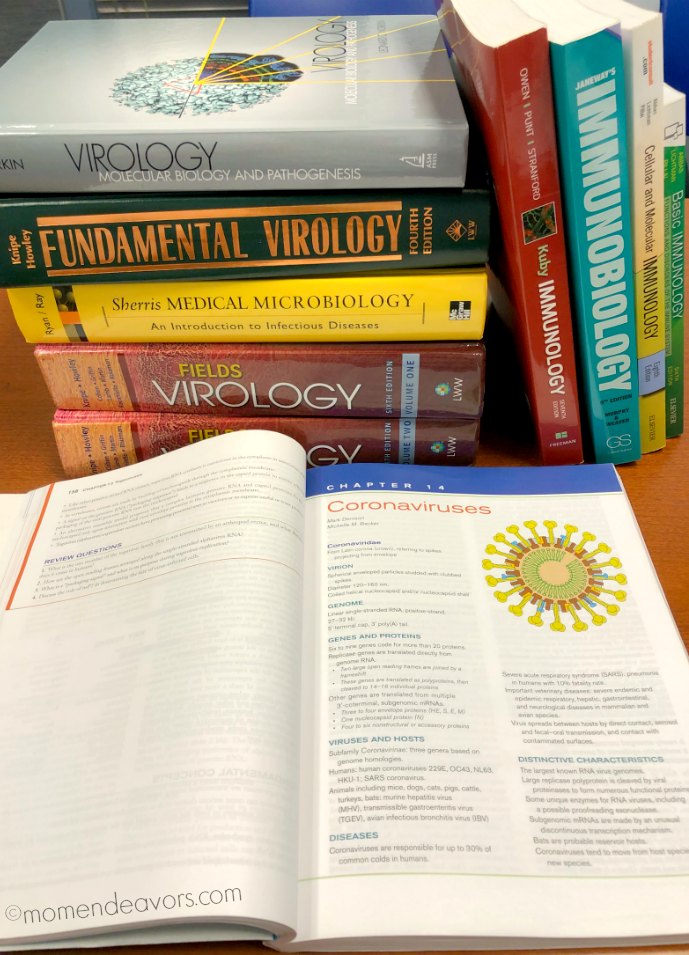 Given our science-nerd backgrounds and his current position, you can imagine that the new coronavirus has been a regular topic of conversation in our house – since early January. As more and more things started happening, the research, reading, data combing, and talks have become more frequent. It’s also something that colleagues have regularly been talking about at his work. Again, since January. The ArcGIS Data from John Hopkins University on the novel coronavirus (subsequently named SARS-CoV-2) was first shared with him on January 30th. That is a LIVE track of the data. Confirmed cases, confirmed deaths, locations, etc. It’s something that we’ve been looking at almost daily since then.
Given our science-nerd backgrounds and his current position, you can imagine that the new coronavirus has been a regular topic of conversation in our house – since early January. As more and more things started happening, the research, reading, data combing, and talks have become more frequent. It’s also something that colleagues have regularly been talking about at his work. Again, since January. The ArcGIS Data from John Hopkins University on the novel coronavirus (subsequently named SARS-CoV-2) was first shared with him on January 30th. That is a LIVE track of the data. Confirmed cases, confirmed deaths, locations, etc. It’s something that we’ve been looking at almost daily since then. 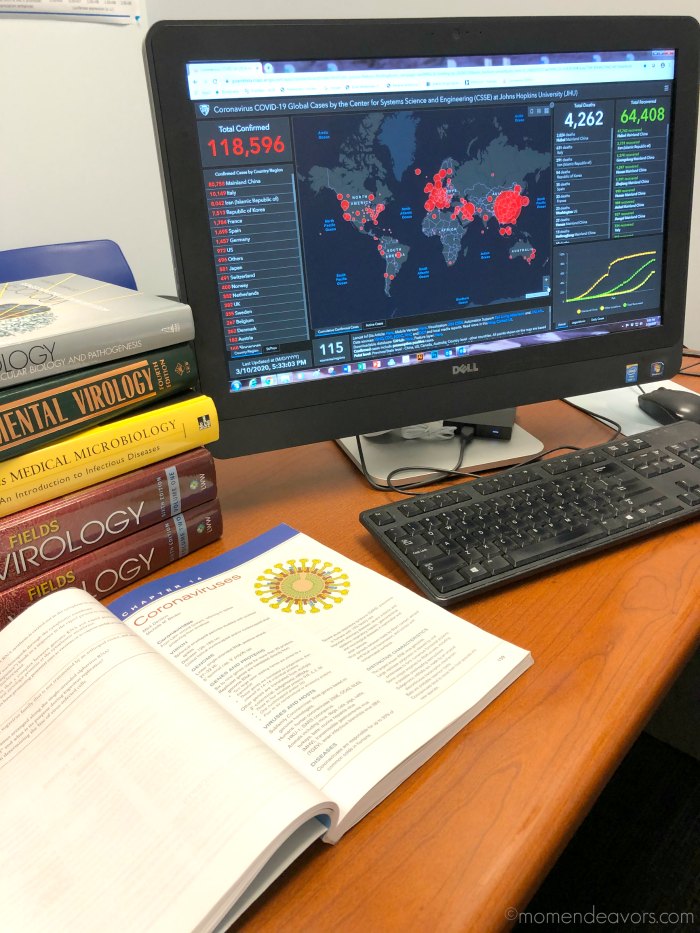 Outside of our more fellow science-nerd circles though, we weren’t seeing much discussion. And all that changed near the end of February when we really started seeing spread outside of China – into Japan, South Korea, and in Italy. I fielded my 1st private message from a friend about the virus (in regards to travel plans) on February 26th who wanted to know our take because of our particular science backgrounds. Since then, my husband and I have been fielding more and more questions from friends and family members.
Outside of our more fellow science-nerd circles though, we weren’t seeing much discussion. And all that changed near the end of February when we really started seeing spread outside of China – into Japan, South Korea, and in Italy. I fielded my 1st private message from a friend about the virus (in regards to travel plans) on February 26th who wanted to know our take because of our particular science backgrounds. Since then, my husband and I have been fielding more and more questions from friends and family members.
The quick spread through Europe was concerning. We started seeing more people talking in real life and on Facebook about it. Then, the outbreak in Washington State. More chatter. Misinformation spreading on Facebook. People saying things to us like “it’s just the flu”. The testing debacle here in the U.S.. Then, my husband’s large biology conference (due to take place in April) was called off a month in advance. And then the mass lock-downs started happening in Italy. The data began to paint a very clear picture to us of what is likely to happen and what we need to prepare for.
It was then (after more and more messages and conversations within our circle) that I decided it was time to put my science teacher hat back on and share our thoughts in one place for friends. So, I put all of the information we felt was really important to share (based on the questions we were getting) into a Facebook post. I never intended to share it publicly there or here on the blog. But, the 1st 3 comments on the post all asked to share it. So, I made the status public and that little Coronavirus info post on Facebook has gone viral. <–You can click there to see the original post (which was originally published on the night of March 9, 2020. 24 hours later, it’s been shared about 650 times). I’m posting a slightly edited version of it below (just for ease of readability here vs. Facebook), along with a little more information.
Here’s the original post (with updates):
Our Coronavirus Take…
Updates to the original post are italicized:
Please note – we are not medical professionals. We are not giving you medical advice. Further, we are not COVID-19 experts (is anyone REALLY at this point?). We are simply sharing our educated thoughts and feelings about what is going on, as people who have science backgrounds and have been monitoring things closely. This is our “science teacher” version of things. 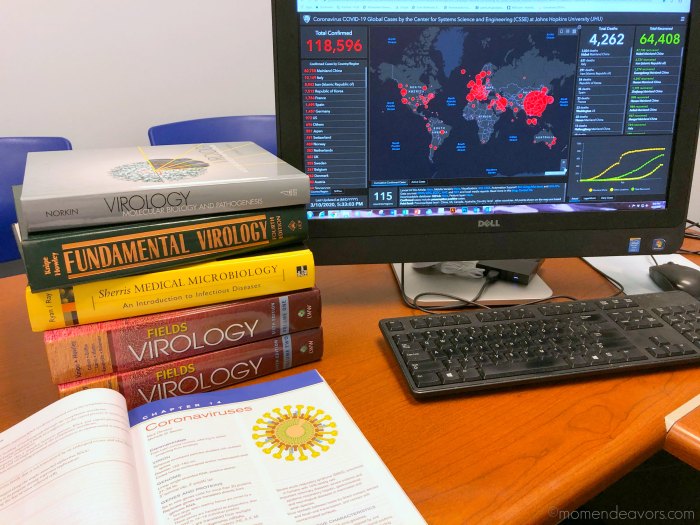
1. Isn’t this just another flu?
No. No it’s not. Biologically/genetically/etc., influenza viruses and coronaviruses are not the same thing. Two different beasts. It’s like comparing apples and oranges – both fruit, both taste good (or in this case – both RNA viruses, both cause respiratory illnesses), but MANY differences beyond that. This is NOT just “another flu”.
2. Why is this coronavirus a big deal?
Because it’s a completely new virus. Biologically, that is a BIG deal. The human race has never seen this particular virus before, so our immune systems have no education on what to do with it. That also means that scientists have very little information to go on compared to other microbes/diseases that we’re used to dealing with (like the flu). So, they need ALL the data they can possibly get in order to learn and make the most educated decisions.
*One important updated note here: Some people are noticing that “human coronaviruses” are listed on the back of disinfectant wipes (like Clorox, Lysol, etc) are germs the wipes kill. This is true. Human coronaviruses are NOT new. In fact, a few different types of human coronaviruses are responsible for 30-40% of the common colds we get each year. SARS and MERS are much more deadly examples of human coronaviruses. So, coronaviruses as a group are NOT new. But *THIS* particular virus, SARS-CoV-2, IS new!
Coronaviruses are just one type of virus. Just like influenza viruses are another type of virus. There are multiple different unique individual viruses that belong to each group and genetically novel viruses can emerge within those classes/types. This is what happened with H1N1 in 2009 (then a NOVEL influenza virus) and that’s what’s happening now with SARS-COV-2 (a NEW coronavirus). It is a virus that has never infected humans before.
Also – it’s important to point out here that SARS-CoV-2 is the name of the specific virus. The disease that particular novel coronavirus causes has now been named COVID-19, which some people have been shortening to just “CV”.
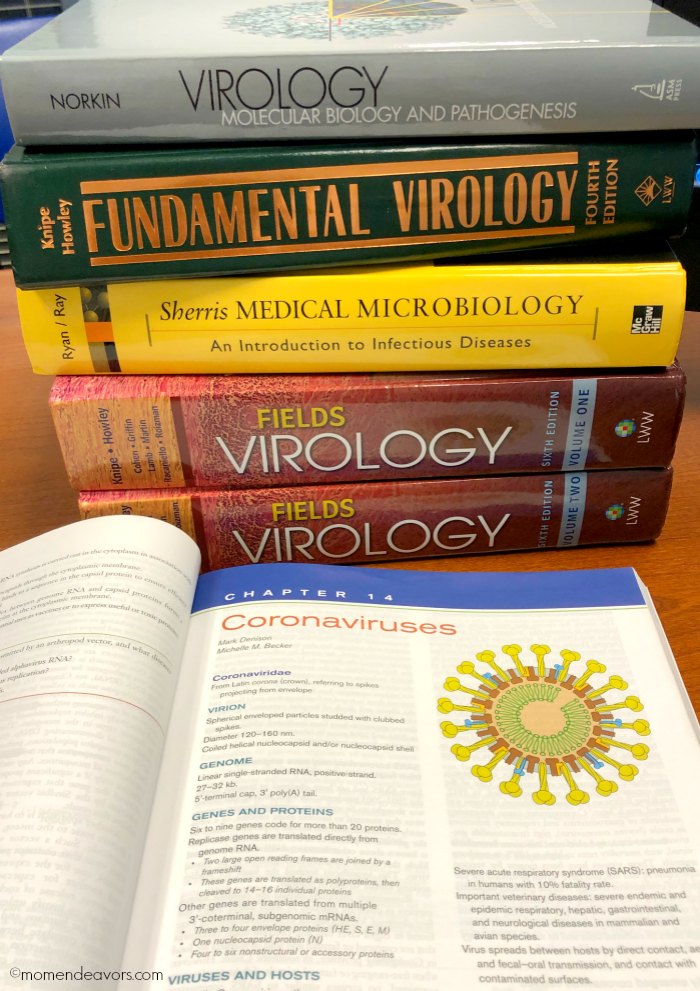
3. Is this going to be even more widespread?
No question. Absolutely yes. We’ve been saying this for weeks, as soon as it jumped out of China. In fact, one of the main reasons we don’t have numbers like Europe yet in the United States is because our system simply isn’t testing enough/as many people. The spread is already happening here.
4. Are we worried?
No and yes. (*as an update to the original Facebook post, we are growing MORE concerned as we read more information from doctors on the front lines of this and continue to look at more data about what is happening).
All the data suggests our immediate family of 5 has a very high likelihood of being ok if we get it. So, we’re not hugely panicked or extremely worried for ourselves, but the risk of illness and complications is definitely concerning. There’s no guarantees with any viral illness, but especially not with a novel one – for any of us. And those stats aren’t the same for our older family members or immunocompromised friends. There’s real reason for concern – especially so for them. *Update – we are increasingly concerned as more data has come out about long-term issues post-Covid.
Hospitals and healthcare systems could QUICKLY become over-run. THAT reason alone is likely why we’re seeing entire countries get put on quarantine/widespread shut-downs. Even though the symptoms are mild for an overwhelming majority of the cases, approximately 5% of the cases that we know about have been critical (or at least requiring some pretty serious medical interventions/support to see them through). That might not sound like much, but when you scale those numbers up to large populations, things get scary fast.
So if 1 million people get the virus (almost certainly likely at this point), then somewhere around 50,000 people are going to need ICU beds. Most areas simply don’t have the healthcare facilities to deal with that. In Italy tonight, healthcare representatives are saying that the heath care system was “one step from collapse” and hospitals are having to set up intensive care treatment in hallways.
Also, those numbers don’t account for FLU patients (which we are still very much in the midst of active season) or all the regular hospital patients that need services (accidents, scheduled surgeries, cancer patients, maternity patients, babies, etc). So the quarantines and lockdowns are NOT just media hype. Those actions are known as non-pharmaceutical interventions (NPI’s) and they can be warranted to slow the spread. Because if everyone gets infected & sick at once, hospitals are going to have a huge problem. And if hospitals have a huge problem, more people die.
*Updated to add: Vox actually shared an article today (March 10, 2020 – the day after I posted the above) that really shows how quarantines WILL save lives. Epidemiologists (public health professionals who study the patterns, causes, and spread of diseases) call this strategy “flattening the curve”. Here’s a good visual representation of that:
Our #FlattenTheCurve graphic is now up on @Wikipedia with proper attribution & a CC-BY-SA licence. Please share far & wide and translate it into any language you can! Details in the thread below. #Covid_19 #COVID2019 #COVID19 #coronavirus Thanks to @XTOTL & @TheSpinoffTV pic.twitter.com/BQop7yWu1Q
— Dr Siouxsie Wiles (@SiouxsieW) March 10, 2020
If you’d like further data on the seriousness of this possibility and what actions must be taken now for this, you can check out this MedPage Today article (written by a John Hopkins University doctor). You can always visit the CDC has their info on COVID-19. And for information about your particular area, head to your state’s Department of Health website for more information.
Update 3/16: Here is a visual representation of how fast this is growing (from ArcGis data linked at the beginning of this post).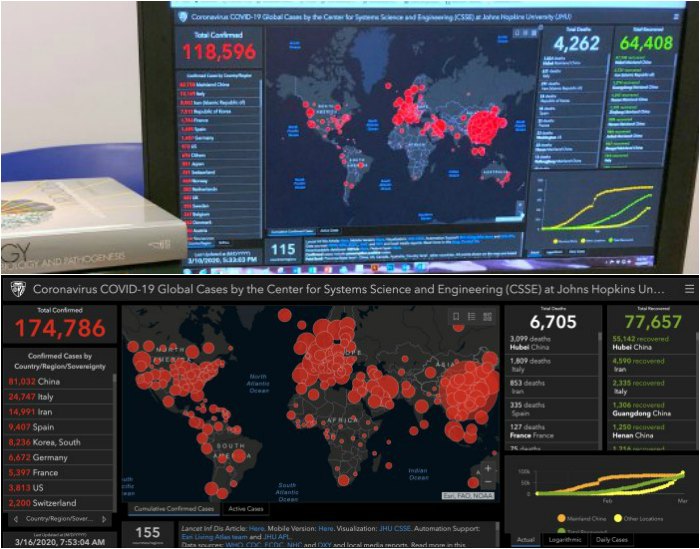 The 1st image was taken in the evening of March 10th. The second is Monday, March 16th in the morning. That means in under one week we have seen over 55,000 newly identified cases and almost 2,500 more deaths. In just the last 24 hours alone, the number has grown by just shy of 20,000. If you know anything about exponential growth rates from math, you know what kind of terrible picture that means then is coming (unless everyone takes the extensive social distancing VERY seriously). This viral Facebook post breaks down the math very clearly.
The 1st image was taken in the evening of March 10th. The second is Monday, March 16th in the morning. That means in under one week we have seen over 55,000 newly identified cases and almost 2,500 more deaths. In just the last 24 hours alone, the number has grown by just shy of 20,000. If you know anything about exponential growth rates from math, you know what kind of terrible picture that means then is coming (unless everyone takes the extensive social distancing VERY seriously). This viral Facebook post breaks down the math very clearly.
5. Are we preparing or doing anything differently?
Yes. No craziness, no insane hoarding of supplies, no fighting over toilet paper.
BUT…we are being even more mindful about hand-washing (which hardly seems possible if you know my husband well, LOL) and we being more diligent about cleaning some items around the house (like our phones).
We have also begun stocking up on items in preparation for quarantine/lock down/shut down/whatever-you-want-to-call-it. NOT hoarding paper towels, toilet paper, and cases of water, but instead buying FOOD, household items, common medical supplies that we’ll want/need if things actually shut down. Again this is NOT panic, not hoarding, not hysteria – just preparedness. We are both more risk-averse and conservative, the kind of people who would rather be “safe than sorry.” We’re using that same M.O. now. After all, “luck favors the prepared”. ? So, we made a list and I’ve been doing shopping to make sure our pantry, freezer, and medicine cabinet are well-stocked. If we don’t use it in the next month or two, no biggie. I’ll just have to do less shopping later then.
*So many of you have asked for more info about this that we published a separate guide with a LARGE list of ideas and considerations! Click here —> How to Prepare & Stock Up for Illness Quarantine!
*UPDATE: Since early April, more suggestion has come out that wearing masks in public is wise. Here are our family’s favorite masks –> Best High-Quality Face Masks
6. What might happen?
Everything is changing so fast, evolving so rapidly, it is virtually impossible to keep up. But, after looking at LOTS of data from around the world, as well as just having his large biology conference called off a month in advance due to Coronavirus concerns, we think there is a real possibility that we could be seeing things shut down like Italy and other countries in Europe & Asia within the next couple weeks. Certain school districts, colleges, areas of towns, etc. here in the US already are shut. Based on data from other countries, it looks like from the 1st clear cut indication of community spread to the date of mass quarantines, lock-downs, travel bans, etc, is about 2 weeks. SO. There’s that.
And even if it isn’t that large a scale, you likely WILL be quarantined if someone in your immediate circle tests positive. More schools will undoubtedly close. We’re going to have to deal with anywhere from major inconveniences to potentially major hardships. So, we are preparing in case that happens.
We hope it doesn’t come to that – but at the same time, we NEED functional hospitals with functional healthcare staff (who are already going to be insanely overworked & more stressed than usual) to have as much fighting power as possible. If you’re friends with a healthcare professional family, keep your germs away from them and send them all the help, prayers, love, & good juju you can. We need them healthy and taken care of!
We’re also cautiously hopeful that we’ll see things play out like China, where about 2 months after the main outbreak things are slowly starting to reopen. Infection rates have drastically declined. They appear to be on the other side of the peak (let’s hope it stays that way).
We have a huge trip to London planned right when school gets out that we desperately hope we’ll still be able to do and a fun cruise trip with friends later in the summer. So far, we’re not cancelling anything with those trips. We have time to wait to see for those. We’re very much hoping to see a return to more normalcy around here by early May. As avid family travelers though, we hate the hit this is to people’s vacations and the travel industry (among all the other WAY more serious tolls this is taking on people’s lives). Update Friday March 13th – it is now clear to us that without a miracle, life will almost for sure NOT be back to normal for safe international travel by the end of May. So, we’ve gone ahead with canceling our London trip already to try to save some money while we are still within many of the cancellation dates.
So, that’s where we stand in the midst of this historical biological event. Thanks for coming to our “TED talk”. ???
Bottom line: Stay informed, use your critical-thinking skills, ask questions if you don’t understand, prepare for some likely major life disruptions for the foreseeable future, be grateful for scientists & advances in science/medicine over the last century, and thank a healthcare worker!
As a friend said when she shared our original Facebook post, “Let’s say NO to panic or denial and YES to information and preparedness”! We wholeheartedly agree!
Do you have more Coronavirus questions? If so, let us know and we’ll do our best to answer!




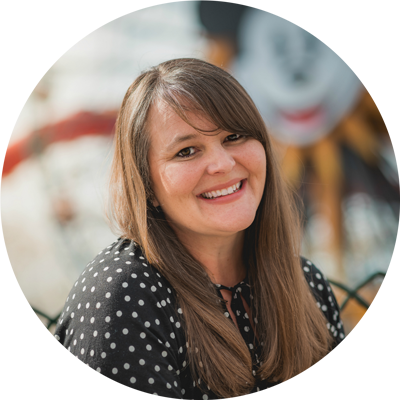





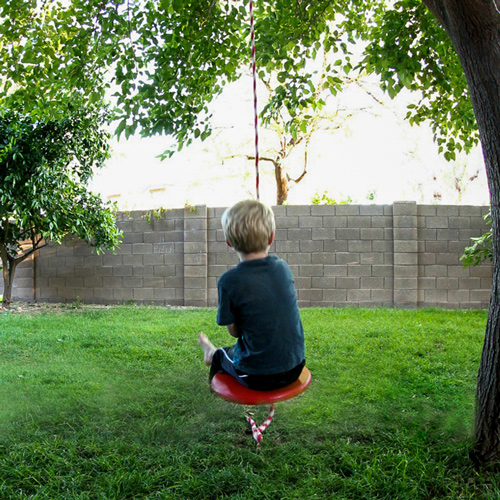
18 Responses
Excellent article, appreciate the attention to detail and the stress on not panicking, but being prepared. I know more than I knew before I read this article, and I thank you for that
My husband and I are scheduled to leave for South America March 21st, returning April 22nd, trip of a life time, including a visit to Rio de Janeiro, Brazil; Buenos Aires, Argentina; Machu Picchu, Peru; Cusco, Ecuador; and the icing on the cake, and our biggest area of concern right now, a 5 day cruise to the Galapagos with 200 people.
I am 61, my husband is 65 and we are both in excellent health. I take no medication and Bob takes a pill for high cholesterol. We received the flu shot in November of 2019, and just took the yellow fever vaccine. We are up to date on the Hepatitis vaccines and Tetanus.
Ugh, do we go? I say yes, but maybe hesitate to get on the boat in 3 weeks, depending on how quickly this continues to escalate, it is the last part of the excursion.
I noticed in your article you alluded to the COV-19 taking off later for the South American countries. Due to the heat there, I guess I was hoping it doesn’t get bad there.
I appreciate your input. Thanks so much!!
Hi Bea,
I’m SO sorry about your bucketlist trip. There’s been SO much change over the past couple of days, that we are assuming a travel ban and full lock-down is coming next (just like much of Europe). In that case, the decision is made for you. We are canceling our trip for May even now as it has become clear to us that (without a miracle), things will indeed NOT be back to normal by then.
I’m so sorry. Hopefully once life does resume back to normal, you’ll be able to take that trip!
Thank you for sane, information.
I heard that as a virus passes from person to person, it mutates and becomes weaker. Is that true? Could we see less serious cases as the virus spreads?
Hi Lindsey,
That can be true. But not always. Unfortunately the opposite can be true as well. Sometimes viruses mutate and can become more infectious/cause more serious infection/be more virulent/etc. So, it really depends. Scientists are gathering all the data they can on this to see if they can determine those very things. So far, two strains have been found of this particular virus.
Sarah, this is the best info I’ve seen yet, and right in line with what I’ve read from infectious disease experts. Thanks for sharing the facts and possibilities without hysteria.
We’re supposed to leave for Hawaii in 8 days. Our doctor say we’re heathy and shouldn’t worry, go on your once in a lifetime vacation, which we are planning on. Your thought? Your article is the most informative thing I’ve read so far, so thank you for that.
Oh Summer, that is so hard! So many of my friends are in similar situations. We have a trip like that planned to London in a few months (so we do more time to see what happens), but it very well may be that we can’t go. And, quite frankly, it sucks. This WHOLE thing SUCKS. There’s really no more eloquent way I can put it.
Your doctor is a medical professional (I’m not) who knows your particular details. So that should definitely be a trusted source.That said, things around the world are changing very rapidly. Cancellations, shut-downs, etc seem to be happening with greater frequency and quickly. So, there is a lot to consider that points to cancelling being the best choice.
LOVE the article! Do you have the list of what you stocked up on? I would like to be prepared but not crazy.
Thanks, Linda! I did get that posted here: https://www.momendeavors.com/how-to-prepare-your-home-for-illness-quarantine/
THANK YOU so much, please keep information coming, it is easier to understand, and helps us not to panic as we are “older” and feel better knowing all we can.
You’re welcome, Carole! Glad you found it helpful!
Great information! My question is about social distancing. At what point do we stop doing our daily routines out and about? So far I’ve mostly read to stay home if you’re sick BUT then I read other articles that say we should suck it up and avoid all unnecessary travel, gyms, etc, to do our part to not catch it and not spread it (perhaps unawares). There’s only been one in my state so far, but we know it’s coming…
Hi Michelle,
If you haven’t already stopped based on the events in the last couple days – you start NOW. Today. It’s time.
I’m a mom of 5 Grandma of 1 whom all live with me my older kids 23-30 are par taking in St. Patrick’s day festivities in the city. I’m a little worried they will bring home the virus after 2 days in the city. My one son has asthma he is 15 my granddaughter 2 years old also has had numerous upper respiratory infections since born croup doing breathing treatments etc.. should I worry about them? Should I ask my older children if they decide to go into the city that they can not return to the house ??♀️ To protect the test of us? Or am I over reacting?
Hi Michele,
You’re right to be concerned. Hopefully in light of the changes the past couple of days, everyone is practicing extreme social distancing now. Those St. Patrick’s Day festivities shouldn’t be happening. So you are NOT over-reacting.
I live in a state where the virus hasn’t heavily impacted us, yet. I know our time is coming, though. That said, I was planning a trip to California in mid-May to visit my VERY elderly mother for her 96th birthday. I’m concerned that even if I don’t have the virus when I leave, I could pick it up at one of the multiple stops along the way and carry it to her. So…the trip is wavering in limbo. Your thoughts, please. I’m very torn about this.
Hi Susan,
Unfortunately, at this point, it doesn’t look like mid-May is going to be “safe” yet (based on the data coming out of China. I know that’s hard to hear – this is HARD. But, we are now canceling our trip for the end of May to be safe. If by some miracle, the situation has markedly improved by then, it seems likely that travel will be able to be re-scheduled/deals found/etc.